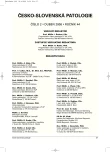Difficulties in Routine Diagnostics of Urothelium Lesions
Authors:
J. Dušková 1; M. Babjuk 2; V. Soukup 2
Authors‘ workplace:
Ústav patologie 1. LF UK a VFN, Katedra patologie IPVZ a Vysoká škola zdravotní, Praha
1; Urologická klinika 1. LF UK a VFN a Katedra urologie IPVZ, Praha
2
Published in:
Čes.-slov. Patol., 44, 2008, No. 2, p. 29-34
Category:
Reviews Article
Overview
Background:
Facing the increasing frequency of urothelial neoplasms and stratified therapeutic strategy pathologists have to meet the demands of urologists for constantly increasing preciseness of the histopathology reports influencing the application of tailored therapeutic schemes. The WHO/ISUP consensus conference in 1998 (5) resulted into adoption of a new classification of the urothelial lesions (11). Its employment requires considering of features that can be difficult to find in the material provided.
Material and methods:
parallel typing of more than 200 urothelial neoplasms from the daily routine biopsy samples provided by the faculty of medicine urology clinic according to the previous Mostofi 1973 and the new WHO/ISUP 1998 classification.
Results:
Realizing the consultation demands we have identified some repetitive problems in the urothelium lesions diagnostics considering typing, grading, and staging of the lesions.
Typing was a less frequent source of problems. It appeared in classifying lesions with inverted growth, and mucin producing urothelial neoplasms vs. adenocarcinomas. Less important typing problems are represented by uncommon rare diagnoses, as they manifest from the beginning as a specialty solvable mostly with the help of immunohistochemistry.
Grading was experienced as troublesome in the following items:
papillary hyperplasia vs. LG papillary ca, PUNLMP vs. LG papillary ca, HG papillary ca with a majority of LG material, monotonous types of HG flat lesions, and combined lesions.
Staging difficulties applied mostly in identification of the initial unequivocal invasion and the substaging of pT1 into pT1a and pT1b with learning to find the decisive mucosa structures described in detail as late as 1983 (2). We have implemented reporting the presence/absence of the detrusor muscle in the material as a marker describing the representativness of the sample provided; we consider this approach less confusing than introduction of clinical staging terminology Ta, T1 instead of pTa, pT1. To help the practising pathologists accustomed to the previous classification system we have organized postgraduate courses dealing with the application of the new diagnostic criteria adopted by the new version WHO 2004 urothelial neoplasms classification. A slide collection from the routine biopsy material comparing the previous and the new classification and a reference image database with commented reference images are being developed in the LUCIA Net image archiving system. Free access for study is available at http://www.laboratory-imaging.com. Recently, it includes over 80 images.
Conclusion:
adopting the new system of urothelial lesions classification requires consideration of formerly not employed features. The learning can be simplified with both classical slide collection & e-learning image database.
Key words:
urothelial pathology – urothelial carcinoma – WHO/ISUP consensus of urothelial lesions classification
Sources
1. Babjuk, M., Matoušková, M., Novák, J.: Doporučené diagnostické a léčebné postupy u uroteliálních nádorů. Galén, Praha, 2003, ISBN80-7262-233-1, s. 51-60.
2. Dixon J.S., Gosling J.A.: Histology and fine structure of the muscularis mucosae of the human urinary bladder. J. Anat., 1983, 136, s. 265-271.
3. Dundr, P., Dudorkinová, D., Povýšil, C., Pešl, M., Babjuk, M., Dvořáček, J., Zelinka T.: Pigmented composite paraganglioma-ganglioneuroma of the urinary bladder. Path. Res. Pract.,199, 2003, 765-769.
4. Dundr, P., Pešl, M., Povýšil, C., Vítková, I., Dvořáček, J.: Large cell neuroendocrine carcinoma of the urinary bladder with lymphoepithelioma-like features. Path. Res. Pract.,199, 2003, 559-563.
5. Epstein, J.I., Amin, M.B., Reuter, V. R., Mostofi, F.K. & the Bladder Consensus Conference Committee: The WHO/ISUP consensus classification of urothelial neoplasms of the urinary bladder. Am. J. Surg. Pathol., 22, 1998, 1435-1448.
6. Hartmann, A., Moser, K. Kriegmair, et al.: Frequent genetic alterations in simple urothelial hyperplasias of the bladder in patients with papillary urothelial carcinoma. Am. J. Pathol., 154, 1999, s. 721-727.
7. Lopez-Beltran, A., Bassi, F. P., Pavone-Macaluso, M., Montironi, R.: Handling and pathology reporting of specimens with carcinoma of the urinary bladder, ureter and renal pelvis. A joint proposal of the European Society of Uropathology and the Uropathology Working Group. Virchows Arch., 2004, 445, 103-110.
8. Mc Kenney, J. K., Gomez, J. A., Desai, S., Lee, M. W., Amin, M. B.: Morphologic expressions of urothelial carcinoma in situ. Am. J. Surg. Pathol., 2001, 25, 356-362.
9. Mostofi, F.K., Sobin, L.H., Torloni H.: Types histologiques des tumeurs de la vessie. Classification histologique internationale des tumeurs No10. OMS, Genéve, 1974.
10. Murphy, M. W.: ASCP survey on anatomic pathology examination of the urinary bladder. Am.J.Clin. Pathol., 1994, 102, 715-723.
11. Pathology and genetics of the urinary system and male genital organs. Chapter 2, Tumours of the urinary system, pp. 90- 157. WHO classification of tumours, IARC Press, Lyon 2004.
12. Pavone-Macaluso, M., Lopez-Beltran, A., Aragona, F., Bassi, P., Fitzpatrick, J.M.: The pathology of bladder cancer: an update on selected issues. BJU Int., 2006, 98, 1161-1165.
13. van der Aa, M. N. M., van Leenders, G .J. L. H., Steyerberg, E. W. et al.: A new system for substaging pT1 papillary bladder cancer: a prognostic evaluation. Hum. Pathol., 36, 2005, 981-986.
14. Younes, M., Sussman, J., True, L. D.: The usefulness of the level of the muscularis mucosae in the staging of invasive transitional cell carcinoma of the urinary bladder. Cancer, 66, 1990, 543-548.
Labels
Anatomical pathology Forensic medical examiner ToxicologyArticle was published in
Czecho-Slovak Pathology

2008 Issue 2
Most read in this issue
- Immunohistochemical Detection of TTF-1 in Intraoperative Bioptic Samples of Adenocarcinoma of the Lung: a Year-Long Experience
- Difficulties in Routine Diagnostics of Urothelium Lesions
- Double Immunostaining with CD1a and CD68 in the Phenotypic Characterization of Indeterminate Cell Histiocytosis
- The 2007 World Health Organisation Classification of Tumours of the Central Nervous System, Comparison with 2000 Classification
